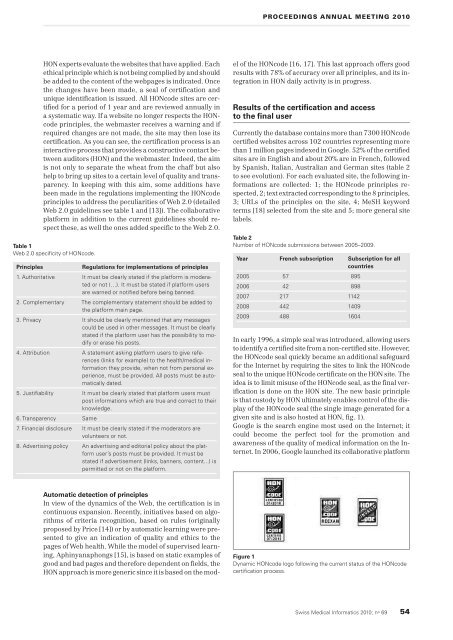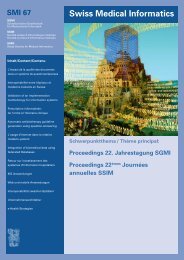Swiss Medical Informatics SMI 69 - SGMI
Swiss Medical Informatics SMI 69 - SGMI
Swiss Medical Informatics SMI 69 - SGMI
Sie wollen auch ein ePaper? Erhöhen Sie die Reichweite Ihrer Titel.
YUMPU macht aus Druck-PDFs automatisch weboptimierte ePaper, die Google liebt.
HON experts evaluatethe websites that have applied.Each<br />
ethical principle which is not being complied by and should<br />
be added to the content of the webpages is indicated. Once<br />
the changes have been made, aseal of certification and<br />
unique identification isissued. All HONcode sites are certified<br />
for aperiod of 1year and are reviewed annually in<br />
asystematic way.Ifawebsite no longer respects the HONcode<br />
principles, the webmaster receives awarning and if<br />
required changes are not made, the site may then lose its<br />
certification. As you can see, the certification process is an<br />
interactive process that provides aconstructive contactbetween<br />
auditors(HON)and the webmaster.Indeed,the aim<br />
is not only to separate the wheat from the chaff but also<br />
help to bring up sites to acertainlevel of quality and transparency.<br />
Inkeeping with this aim, some additions have<br />
been made in the regulations implementing the HONcode<br />
principles to address the peculiarities of Web2.0 (detailed<br />
Web2.0 guidelinessee table 1and [13]). The collaborative<br />
platform in addition to the current guidelines should respectthese,<br />
as well the ones added specific to the Web2.0.<br />
Table 1<br />
Web 2.0 specificity ofHONcode.<br />
Principles Regulations for implementations of principles<br />
1. Authoritative Itmust be clearly stated if the platform is moderated<br />
or not (…). It must be stated if platform users<br />
are warned or notified before being banned.<br />
2. Complementary The complementary statement should be added to<br />
the platform main page.<br />
3. Privacy It should be clearly mentioned that any messages<br />
could be used in other messages. It must be clearly<br />
stated if the platform user has the possibility tomodify<br />
or erase his posts.<br />
4. Attribution Astatement asking platform users to give references<br />
(links for example) to the health/medical information<br />
they provide, when not from personal experience,<br />
must be provided. All posts must be automatically<br />
dated.<br />
5. Justifiability Itmust be clearly stated that platform users must<br />
post informations which are true and correct to their<br />
knowledge.<br />
6. Transparency Same<br />
7. Financial disclosure It must be clearly stated if the moderators are<br />
volunteers or not.<br />
8. Advertising policy An advertising and editorial policy about the platform<br />
user’s posts must be provided. It must be<br />
stated if advertisement (links, banners, content...) is<br />
permitted or not on the platform.<br />
Automatic detection of principles<br />
In view ofthe dynamics of the Web, the certification is in<br />
continuousexpansion. Recently,initiatives based on algorithms<br />
of criteria recognition, based on rules (originally<br />
proposed by Price[14]) or by automaticlearning werepresented<br />
to give an indication ofquality and ethics tothe<br />
pages of Webhealth. While the model of supervised learning,Aphinyanaphongs<br />
[15], is based on static examples of<br />
goodand bad pages and therefore dependent on fields, the<br />
HON approachismore generic sinceitisbased on the mod-<br />
PROCEEDINGS ANNUAL MEETING 2010<br />
el of the HONcode [16, 17]. Thislast approachoffers good<br />
resultswith 78%ofaccuracy over allprinciples,and its integration<br />
in HON daily activity is in progress.<br />
Results ofthe certification and access<br />
to the final user<br />
Currentlythe database contains more than 7300 HONcode<br />
certified websites across 102 countries representing more<br />
than 1million pagesindexed in Google. 52% of the certified<br />
sites are in English and about20% are in French, followed<br />
by Spanish, Italian, Australian and German sites (table 2<br />
to see evolution). For each evaluated site, the following informations<br />
are collected: 1; the HONcode principles respected,<br />
2; text extracted corresponding to the 8principles,<br />
3; URLs of the principles on the site, 4;MeSH keyword<br />
terms [18] selected from the site and 5; more general site<br />
labels.<br />
Table 2<br />
Number of HONcode submissions between 2005–2009.<br />
Year French subscription Subscription for all<br />
countries<br />
2005 57 895<br />
2006 42 898<br />
2007 217 1142<br />
2008 442 1409<br />
2009 488 1604<br />
In early 1996,asimpleseal was introduced,allowing users<br />
to identifyacertified site from anon-certified site. However,<br />
the HONcode seal quickly became an additional safeguard<br />
for the Internet by requiring the sites to link the HONcode<br />
seal to the uniqueHONcodecertificate on the HON site. The<br />
idea is to limitmisuseofthe HONcode seal, as the final verification<br />
is done on the HON site. The new basic principle<br />
is that custody by HON ultimately enables controlofthe display<br />
of the HONcode seal (the single imagegenerated for a<br />
given site and is also hosted at HON, fig. 1).<br />
Google is the search engine most used on the Internet; it<br />
could become the perfect tool for the promotion and<br />
awareness of the quality of medical information on the Internet.<br />
In 2006, Google launched its collaborative platform<br />
Figure 1<br />
Dynamic HONcode logo following the current status of the HONcode<br />
certification process.<br />
<strong>Swiss</strong> <strong>Medical</strong> <strong>Informatics</strong> 2010; n o <strong>69</strong><br />
54



